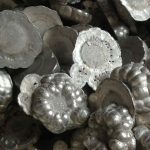Deprecated: get_settings is deprecated since version 2.1.0! Use get_option() instead. in /www/sites/alloy.wiki/index/wp-includes/functions.php on line 4862
Titanium: Titanium alloy has low density, high specific strength, good corrosion resistance, low thermal conductivity, non-toxic, non-magnetic, and weldable; it is widely used in aviation, aerospace, chemical, petroleum, electric power, medical, construction, sporting goods and other fields .
Commonly used welding methods for titanium and titanium alloys are: argon arc welding, submerged arc welding, vacuum electron beam welding, etc.
Preparation before welding
The surface quality of weldment and titanium welding wire has a great influence on the mechanical properties of welded joints, so it must be strictly cleaned.
- 1) Mechanical cleaning of weldments that do not require high welding quality or difficult to pickling can be wiped with fine sandpaper or stainless steel wire brush, but it is best to scrape the titanium plate with hard alloy yellow to remove the oxide film.
- 2) Chemical cleaning: the test piece and welding wire can be pickled before welding. The pickling solution can be HF (5%) + HNO3 (35%) water melt. Rinse with clean water after pickling and apply soldering immediately after drying. Or use acetone, ethanol, carbon tetrachloride, methanol, etc. to wipe the groove of the titanium plate and its two sides (within 50mm each), the surface of the welding wire, and the part where the tool and fixture are in contact with the titanium plate.
- 3) Selection of welding equipment: For argon arc welding of titanium and titanium alloy tungsten plates, a DC argon arc welding power source with external characteristics and high-frequency arc ignition should be used, and the delayed gas delivery time should not be less than 15 seconds to prevent the weldment from being oxidized. ,Pollution.
- 4) Selection of welding materials: the purity of argon gas should not be less than 99.99%, the dew point should be below -40℃, and the total mass fraction of impurities should be 0.001%. When the pressure in the argon cylinder drops to 0.981MPa, stop using it to prevent the quality of the welded joints from being affected.
- 5) Gas protection and welding temperature: When welding titanium pipe joints, in order to prevent the welding joints from being polluted by harmful gases and elements at high temperatures, necessary welding protection and temperature control must be carried out on the welding area and welds, and special The protective drag hood provides full protection, and its temperature should be below 250°C.
Operation essentials
- 1. In manual argon arc welding, the angle between the welding wire and the weldment should be kept as small as possible (10~15°). The welding wire is fed into the molten pool smoothly and evenly along the front end of the molten pool, and the end of the welding wire must not be moved out of the argon gas protection zone.
- 2. During welding, the welding torch basically does not swing horizontally. When it needs to swing, the frequency should be low and the swing amplitude should not be too large to prevent it from affecting the argon protection.
- 3. When the arc is broken and the welding seam is finished, the argon gas protection should be continued until the welding seam and the metal in the heat-affected zone are cooled to below 350℃ before removing the welding torch.
Surface color of weld and heat-affected zone
1. Weld area
Silvery white, light yellow (allowed for the first, second and third level welds); dark yellow (allowed for the second and third level welds); golden purple (allowed for the third level welds); dark blue (allowed for the first, second and third level welds) Are not allowed).
2. Heat Affected Zone
Silvery white, light yellow (allowed for the first, second, and third level welds); dark yellow, golden purple (allowed for the second and third level welds); dark blue (allowed for the third level welds).
Link to this article:How to weld titanium?
Reprint Statement: If there are no special instructions, all articles on this site are original. Please indicate the source for reprinting:Alloy Wiki,thanks!^^


